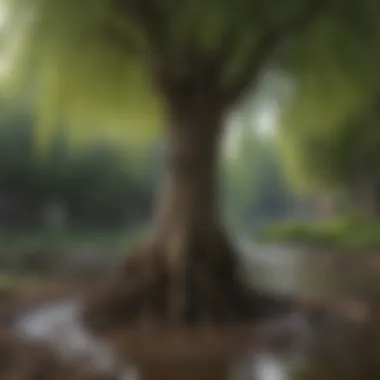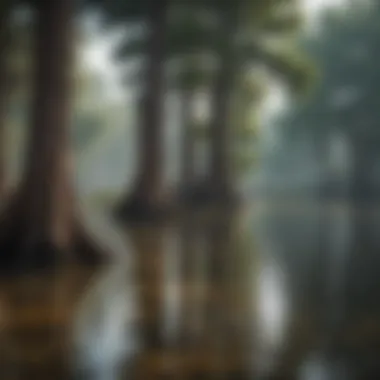Trees That Thrive in Wet Soil Conditions


Intro
Wet soil conditions can present unique challenges for both homeowners and landscape designers. However, certain trees not only survive but thrive in these environments. This guide aims to unveil the variety of species that prefer damp settings, spotlighting their characteristics, ecological roles, and practical uses. By understanding these trees, one can make informed decisions that enhance their landscapes, even in tricky moisture conditions.
Design Inspiration
Trending Styles
When considering wetland tree selections, the design inspiration can take many forms. There are various styles that incorporate the unique aesthetics of moisture-loving trees. For instance, a naturalistic design might use a mix of willows, alders, and cypress trees. These species not only provide structural interest but can contribute to a serene atmosphere in gardens or parks.
Additionally, incorporating trees like bald cypress or river birch can bring texture and verticality to space. Their distinctive forms can contrast beautifully with broader foliage, creating depth and visual intrigue.
Color Palettes
Color palettes for landscaping with wet-soil trees can vary widely. Dark green canopies of black willow pair beautifully with lighter hues from red maple’s foliage in the fall. The use of evergreens such as hemlock can offer a rich backdrop year-round while providing various shades of green. As seasons change, these can produce a harmonious blend of colors that breathe life into the landscape.
Practical Tips
Maintenance & Care
Caring for trees in wet environments requires specific strategies:
- Irrigation: While these species are tolerant of excessive moisture, over-saturation can still cause root rot. Ensure proper drainage to keep roots healthy.
- Pruning: Regular pruning helps maintain shape and health. Focus on removing dead or weak branches to enhance air flow and light penetration.
- Pest Management: Monitor for pests that thrive in damp conditions, such as aphids. Employ natural remedies where possible to maintain ecological integrity.
Budgeting & Planning
When budgeting for planting trees that prefer wet soil, consider the following elements:
- Tree Cost: Prices can vary significantly depending on species and size. For instance, black gum may be less expensive than an established cypress tree.
- Site Preparation: Wet areas may require additional work to establish proper drainage. Having this prepared in advance will help in long-term care and cost management.
- Soil Amendments: Consider the type of soils present. Adding organic matter can enhance soil structure, thus promoting healthier root systems.
The right tree selection can significantly improve both the aesthetic and ecological value of wet areas in your landscape.
By embracing trees that thrive in wet soil conditions, you not only improve aesthetic value but also contribute positively to local ecosystems. This guide provides the knowledge needed to explore suitable options and practical approaches for a flourishing landscape.
Foreword to Wet Soil Environment
Understanding the wet soil environment is essential for those engaged in gardening, landscaping, and ecological restoration. This environment influences tree selection, growth patterns, and the overall health of the ecosystem. Wet soil ecosystems present distinct challenges and opportunities. It is crucial to recognize the moisture levels, nutrient availability, and the unique biological interactions occurring within these areas.
Definition of Wet Soil
Wet soil refers to soil that retains moisture for extended periods, often resulting from inadequate drainage, high groundwater levels, or occasional flooding. This condition fosters a unique habitat conducive to specific tree species. Typically, wet soils are found in low-lying areas, near riverbanks, or in swamps. The saturation of the ground influences the types of organisms that flourish in these regions. It impacts root respiration, nutrient uptake, and overall plant growth.
Importance of Soil Moisture
Soil moisture plays a vital role in supporting plant life. Its presence ensures that trees receive the essential water they need for photosynthesis and nutrient transport. Moreover, moist soil influences the soil microbiome, which contributes to nutrient cycling and soil health. The importance of soil moisture cannot be understated, especially in promoting biodiversity. Trees adapted to wet conditions often create habitats for various wildlife, contributing to the ecological balance in their environment. The management of soil moisture is crucial not only for tree health but also for maintaining the broader ecosystem resilience.
Understanding Tree Preferences
Understanding the preferences of trees that thrive in wet soil is crucial for anyone looking to cultivate a successful landscape in moisture-rich environments. Trees play a significant role in maintaining ecological balance, and knowing which trees best suit these conditions ensures that they can grow healthy and continue to provide their many benefits. This knowledge can also aid in making informed decisions when it comes to landscaping and vegetation management in humid or swampy areas.
Factors Influencing Tree Growth in Wet Soil
Several key factors influence the growth of trees in wet soil. These include:
- Soil Type: The composition of the soil can significantly affect water retention levels and nutrient availability. Soils that are more clay-based tend to retain moisture better but can also lead to poor drainage. Sandy soils, although well-drained, might not retain enough moisture for certain tree species.
- Water Table Levels: The height of the water table in relation to tree roots impacts growth as well. Species that prefer consistently moist soil may struggle in areas where the water table fluctuates dramatically.
- Oxygen Availability: Wet soils often have limited oxygen, posing challenges for many tree species. Trees that prefer wet conditions, like willows, have evolved ways to adapt to lower oxygen levels.
- Temperature and Climate: Different tree species have varied climate requirements. Warmer areas might support a different range of trees compared to cooler, temperate regions.


Adaptations of Trees to Moisture-Rich Environments
Trees that thrive in wet soils exhibit several adaptations that allow them to manage the challenges presented in these environments.
- Aerenchyma Formation: Many species develop specialized tissues called aerenchyma. This allows for enhanced gas exchange between roots and the atmosphere, which is critical in oxygen-poor wet soils.
- Shallow Root Systems: Wetland trees frequently develop shallow yet extensive root systems. This setup helps maximize uptake of moisture from the surface soil and prevents drowning in extended periods of flooding.
- Flexible Growth Forms: Some trees grow with a more flexible trunk and branch structure, enabling them to withstand strong winds and water currents often found in wetland regions.
Adaptive strategies are essential for survival in these unique ecosystems.
In summary, understanding tree preferences when it comes to wet soil conditions involves examining various factors that affect growth and the adaptations trees have developed. Homeowners and landscape enthusiasts need to consider these details when making tree selections for areas prone to moisture-related challenges.
Types of Trees That Thrive in Wet Soil
Understanding the varieties of trees that flourish in wet soil conditions is essential for any gardening project focused on moisture-rich areas. Such trees not only contribute to the biodiversity of a region but also provide numerous ecological benefits. They can help stabilize soil, assist in purifying water, and offer habitats for various wildlife. Choosing trees specialized for these environments ensures that they will thrive in the long term while enhancing the overall ecological health of wetland areas.
Deciduous Trees Suitable for Wet Conditions
Willow
The Willow tree is known for its graceful appearance and rapid growth. It thrives near water bodies making it an excellent choice for wet soil. One key characteristic of Willows is their fibrous root system which effectively stabilizes soil and prevents erosion. This tree is appreciated for its adaptability to various soil types, but it does require ample moisture. However, its rapid growth can sometimes lead to invasive growth patterns if not carefully monitored.
Red Maple
Red Maple is another species that performs well in wet conditions. This tree is valued for its stunning fall color and its resilience in varying moisture levels. The roots of the Red Maple can tolerate flooding, which adds to its appeal for wetland areas. A significant advantage of this species is its ability to thrive in both wet and dry soils, making it versatile for different planting situations. The drawback is that it may grow less vigorously in extremely dry areas compared to more consistent moisture levels.
Sweet Gum
Sweet Gum is a unique deciduous tree not only for its star-shaped leaves but also for its adaptability to wet soils. This tree is beneficial for providing shade and habitat for local wildlife. Its gum production can be both an advantage and disadvantage; while it offers potential for unique uses, fallen gum balls can be a nuisance in landscaped areas. The adaptability of Sweet Gum makes it a worthy consideration for wet soil regions, as it can enrich the ecosystem.
Evergreen Trees for Moist Soils
Southern Cedar
Southern Cedar is a tall, beautiful tree known for its aromatic wood. It thrives in moist, acidic soil and does well in low-lying areas such as swamps. This tree plays a vital role in the ecosystem, providing shelter for various birds and animals. Its foliage stays green year-round, which adds aesthetic value to landscaping projects. One consideration is the potential for rot in older trees if not properly maintained.
Atlantic White Cedar
Atlantic White Cedar is another evergreen that flourishes in wet environments. It is renowned for its durability and resistance to decay. This tree serves as a critical component in wetland areas, often forming dense thickets that provide habitat for wildlife. The wood of Atlantic White Cedar is valuable for construction; however, its growth can be slow, which may require patience if it is being used in restoration projects.
Notable Native Trees in Wet Soil
Black Tupelo
Black Tupelo is notable for its adaptability to a range of wet conditions. It features bright green foliage that turns a stunning reddish-purple in the fall. This tree is crucial for wildlife, offering berries that attract birds. Black Tupelo is an excellent choice for anyone looking to enhance their landscape with a native tree that supports local ecosystems. One downside is that it may take several years to establish fully.
Swamp White Oak
Swamp White Oak is often found along rivers and wetlands. This tree is distinguished by its strong and sturdy trunk. It can absorb significant amounts of water, making it ideal for areas with poor drainage. Swamp White Oak is also known for its architectural beauty, providing shade and a habitat for countless species. However, if planted in overly dry soils, its growth may become stunted, limiting its potential.
Ecological Role of Trees in Wetlands
Trees in wetlands play an essential role in maintaining the ecological balance of these unique environments. They not only contribute to the aesthetic value but also provide numerous practical benefits that enhance the health of wet soil ecosystems. Understanding their ecological role can guide homeowners and designers in selecting appropriate tree species for wet areas, promoting sustainability.
Erosion Control and Soil Stability
One of the primary functions of trees in wetland areas is erosion control. The root systems of trees, particularly species such as the willow and black tupelo, help stabilize soil and prevent erosion by binding the sediment together. When heavy rains occur or when floodwaters rise, the trees act as natural barriers. Their roots absorb vast amounts of water, reducing runoff and helping to maintain moisture in the soil.


Moreover, trees encourage the deposition of sediments, as they slow down water flow. Over time, this process can lead to the creation of more stable landforms, fostering diverse habitats.
In addition, healthy trees in wetlands also improve soil conditions by enhancing its structure. They contribute organic matter through leaf fall and decaying roots. This organic material provides nutrients vital for other plant species, creating a thriving ecosystem where plants can coexist with the trees. Thus, planting trees adapted to wet conditions not only enhances soil stability but also promotes biodiversity.
Habitat for Wildlife
Wetland trees serve as vital habitats for a wide range of wildlife. They become homes for several species of birds, mammals, and insects, creating a rich biodiversity hotspot. For instance, the southern cedar is known to provide nesting sites for various birds, while its foliage serves as cover for small mammals and other wildlife.
The leaves and fruit of these trees also contribute to the food web. As they fall into the water or onto the ground, they are broken down by microorganisms. This process supplies nourishment not just to plants but also to aquatic organisms, thus supporting the entire ecosystem.
In summary, the ecological role of trees in wetlands cannot be overstated. They prevent erosion, stabilize soil, and provide essential habitats for wildlife. For those looking to enhance their wet areas, choosing the right tree species can lead to a healthier, more balanced ecosystem.
"The presence of wetland trees is crucial for maintaining the health of these environments, making tree selection a key consideration for landscaping and environmental stewardship."
Practical Considerations for Planting
When selecting trees for wet soil environments, understanding the practical considerations is essential for successful growth. Wet soil presents unique challenges and opportunities that can significantly influence the survival and health of trees. Homeowners and gardeners can benefit from careful planning and informed decisions in several areas, including the selection of location, soil preparation, and ongoing maintenance. This guide aims to provide clarity on these important aspects.
Choosing the Right Location
The first step in planting trees that prefer wet soil is identifying the optimal location. Not all wet areas are created equal. Spotting a site with consistent moisture is critical. Additionally, consider both sun exposure and terrain slopes.
Factors to evaluate include:
- Sunlight Access: Some trees thrive in full sun, while others can tolerate shade. Assess the amount of sunlight your chosen area receives throughout the day.
- Water Flow: Determine if the area is prone to waterlogging or has good drainage to support tree roots. Trees may struggle if water accumulates for long periods.
- Proximity to Structures: Planting trees close to buildings can have long-term consequences. Roots may interfere with foundations, while foliage can block views or light.
Choosing the right location sets the foundation for successful growth and eventual health of wet soil trees.
Soil Preparation Techniques
Once location is set, soil preparation becomes vital. Wet soil often has different properties compared to drier soils. Here are some practical techniques to prepare the soil:
- Testing Soil pH: It is necessary to understand the pH level of the soil, as certain trees prefer acidic or alkaline conditions.
- Improving Drainage: If the area collects excessive water, improve drainage by incorporating organic matter or creating raised beds. This allows excess water to flow away from base roots.
- Adding Nutrients: Wet soils can also benefit from nutrient enhancement. Compost or well-rotted manure can increase soil fertility, promoting healthy growth.
Soil prep improves not only the immediate growing conditions but also long-term tree health.
Maintenance for Optimal Growth
Even after planting, ongoing maintenance is crucial for the thriving of trees in wet environments. Regular checks and care can prevent many issues.
- Watering Practices: While the soil is wet, overwatering can still occur. Monitor soil moisture regularly to avoid drowning the roots.
- Mulching: Applying mulch around the base helps regulate soil temperature and moisture. It reduces competition from weeds that may thrive in wet conditions.
- Pest Control: Keep an eye on potential pests. Trees in wet soils can attract insects and diseases unique to these environments. Early detection is key to management.
By ensuring proper maintenance post-planting, homeowners can look forward to healthy trees that contribute positively to their landscape.
"Planting trees in wet soil can be a rewarding endeavor when approached thoughtfully and methodically."
In summary, the practical considerations for planting trees in wet soil greatly influence their chances for survival and growth. The right location, adequate soil preparations, and attentive maintenance constitute the backbone of successful landscaping in such environments.
Landscaping with Wet Soil Trees
Landscaping with trees that thrive in wet soil requires specific knowledge and strategic planning. Wet areas can be challenging for some plants but provide unique opportunities for others. Utilizing trees that prefer these moist environments can enhance aesthetic appeal and improve ecological functions.
Incorporating wet soil trees can greatly benefit environments prone to flooding or constant moisture. Not only do these trees serve as a beautiful element in landscape design, they also play a critical role in water management. They support soil stability, mitigate the effects of erosion, and provide habitats for various wildlife species.
When planning a landscape with wet soil trees, careful consideration must be given to the characteristics of the site and the trees themselves. Trees that prefer wet conditions often have adaptable root systems that can handle saturation. Choosing the right species can lead to a flourishing ecosystem that benefits both the homeowner and local wildlife.


Design Considerations for Wet Areas
A successful landscape incorporating trees that thrive in wet soil must consider several elements. First, understanding the specific moisture levels and soil types in your yard is essential. Testing the soil can give insight into its pH and drainage characteristics, guiding the selection of trees that will perform well.
It's advisable to design the layout so that taller trees are placed strategically. This allows for sunlight to reach smaller plants and undergrowth. Also, consider the height and spread of trees. Large species can overshadow smaller plants, affecting their health and growth.
In addition, incorporating diverse plant species can enhance ecological balance. Grouping trees by moisture needs can create a more natural environment, helping to maintain soil moisture levels. This layering approach also encourages habitat diversity, benefiting local fauna.
Complementary Planting Strategies
Using complementary species along with wet soil trees can further optimize your landscape. This approach promotes biodiversity and improves soil health. For instance, pairing trees with moisture-loving shrubs and ground covers can create a thriving micro-ecosystem.
Invasive species should be avoided. Instead, choose native plants that support local wildlife and require similar moisture levels. For example, planting ferns or sedges around the base of willow trees can thrive in the wet conditions while contributing to the aesthetics of the area.
Additionally, consider the use of water features, such as ponds or rain gardens, alongside wet soil trees. These elements can enhance the visual appeal and functionality of the landscape, providing a natural habitat for aquatic species and helping with drainage.
"Incorporating trees that thrive in wet soil conditions can transform challenging areas into vibrant ecosystems that benefit both the homeowner and local wildlife."
Overall, understanding the specific needs of wet soil trees, their role in the landscape, and their interactions with other plants will lead to a cohesive and functional outdoor space. By carefully considering these aspects, homeowners and designers can create a landscape that is not only beautiful but also ecologically beneficial.
Challenges of Growing Trees in Wet Soil
Growing trees in wet soil presents a unique set of challenges that can impact both the health of the trees and the surrounding ecosystem. Understanding these challenges is crucial for anyone aiming to cultivate trees in moisture-rich environments. The wet conditions can lead to problems such as limited oxygen availability, which directly affects root development. Moreover, specific pests and diseases thrive in these conditions, presenting significant risks that need to be managed effectively.
Key considerations when managing trees in wet soil include pest control, disease prevention, and climate adaptability.
Potential Pests and Diseases
Trees in wet soil conditions can become susceptible to various pests and diseases. The high moisture levels often create an ideal breeding ground for insects such as aphids, which feed on tree sap, weakening the trees over time. Additionally, fungal infections, like root rot and leaf spot, are more prevalent in soggy environments. These diseases can compromise tree vitality, leading to stunted growth or even death.
Management practices should focus on early detection and intervention. Regular monitoring for signs of infestation and maintaining good airflow around the trees can significantly reduce the risk of these issues. Consider the following strategies to combat pests and diseases:
- Implement integrated pest management to minimize chemical use.
- Utilize resistant tree species when selecting trees for wet areas.
- Promote biodiversity in the landscape to encourage natural predators.
Climate Considerations
Climate plays a critical role in the success of trees in wet soil. Variations in temperature, rainfall, and humidity can significantly affect tree growth and resilience. For instance, regions with excessive rainfall might face challenges such as soil erosion and nutrient leaching, which can adversely affect tree health.
Furthermore, understanding the seasonal changes in temperature and precipitation is vital. Trees that flourish in wet soil may require different care strategies dependent on the climatic shift. It is important to consider:
- Selecting tree species adapted to local climate conditions.
- Implementing drainage solutions in areas prone to flooding.
- Monitoring seasonal weather patterns to anticipate stress on tree health.
Culmination and Future Directions
In wrapping up the exploration of trees that prefer wet soil, it is essential to recognize the profound role these trees play in both ecological and practical dimensions. Their ability to thrive in waterlogged conditions offers diverse benefits, ranging from erosion control to providing habitats for various wildlife. The unique adaptations these trees possess enable them to not only survive but flourish where most other species would struggle.
Understanding the key points discussed throughout the article complements the broader perspective on environmental conservation and landscape planning. The relevance of selecting appropriate trees for wet soil cannot be overstated, as it impacts the overall health of local ecosystems and contributes to effective water management strategies.
Summary of Key Points
- Trees adapted to wet soil conditions include both deciduous and evergreen species.
- Ecological functions encompass erosion control, habitat creation, and promoting biodiversity.
- Practical considerations for planting involve site selection, soil preparation, and ongoing maintenance.
- Managers and homeowners must be aware of challenges such as pests and climate factors affecting tree health.
Opportunities for Further Research
As science advances, many opportunities arise for further studies related to trees that thrive in wet soil. Areas that warrant additional research include:
- Genetic studies on the resilience of wet soil trees to climate change and fluctuating moisture levels.
- Long-term ecological impacts of introducing specific tree species into wetlands, especially relating to biodiversity and ecosystem services.
- Pest management strategies tailored to the unique environment of wet soils and their vulnerable tree species.
- Community engagement efforts that promote the planting of appropriate trees in urban settings, enhancing green spaces while addressing local environmental challenges.
By diving deeper into these avenues, stakeholders can identify solutions that both preserve and enrich the natural landscape.
In summary, continuing to research and understand the significance of wet soil trees will enhance conservation efforts and inform future landscaping practices. These initiatives contribute to a balanced approach to environmental management, integrating community needs with ecological preservation.















